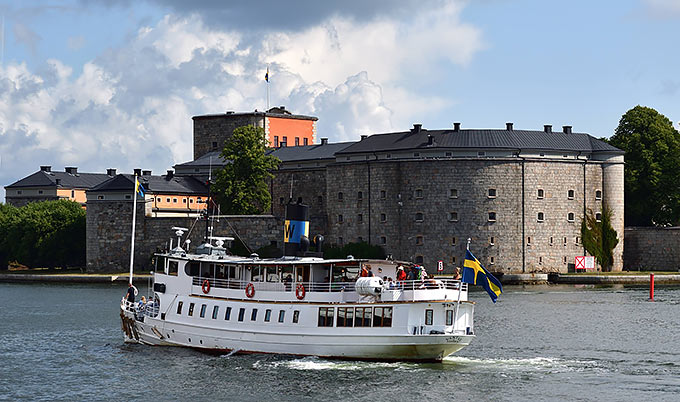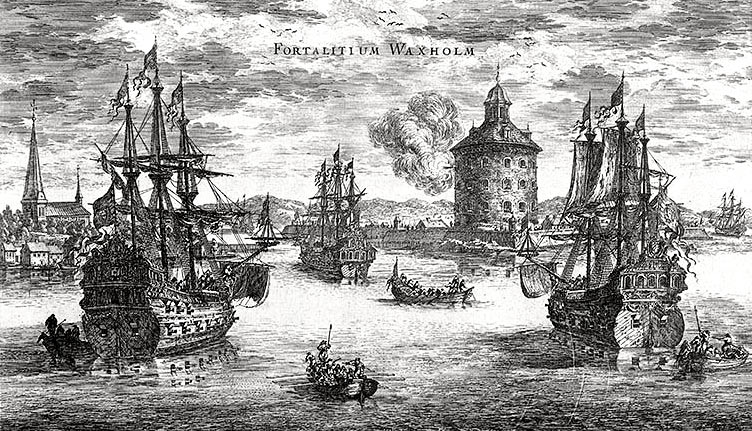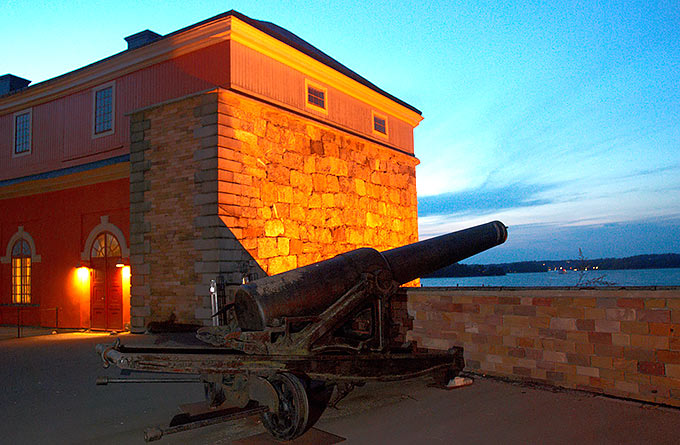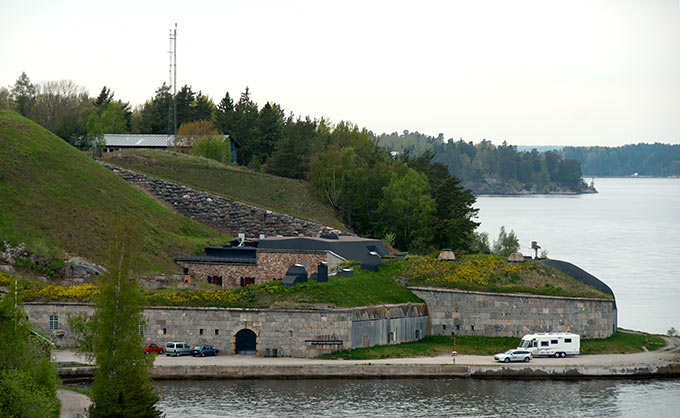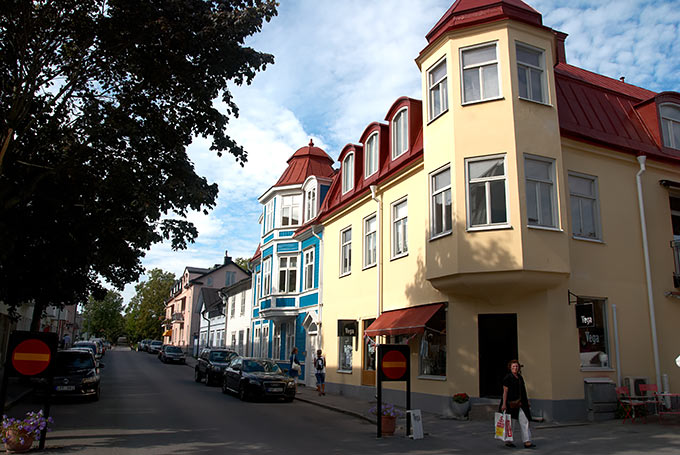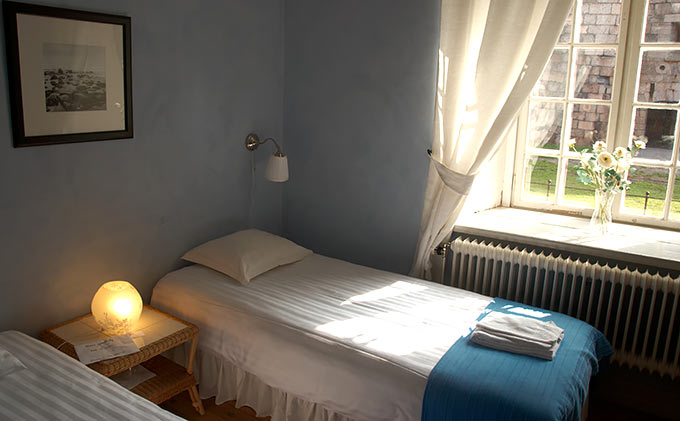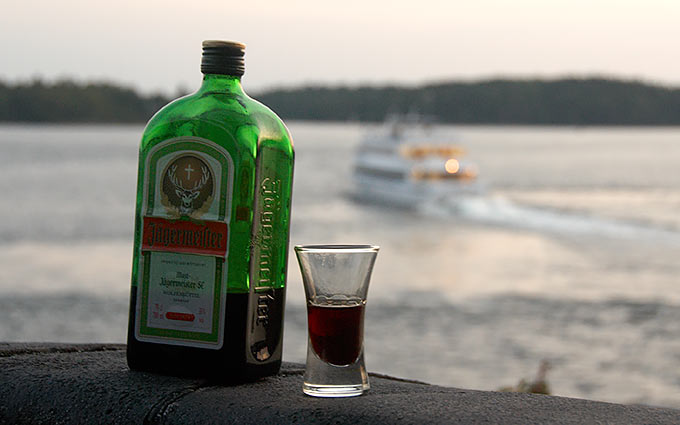History of Vaxholm fortress
The strategic importance of this place was understood long ago. There is the shipping route, leading to the Swedish capital of Stockholm, is divided into two branches. A broad and deep Oksdupet channel was dammed by rocks in 1548. Stone-and-wooden gun blockhouse was built on a rocky island in the middle of the other branch Kodjupet channel back in 1510 under the regent Svante Sturre Jr. rule.
In the 1544 Riksdag made a decision about the construction of permanent fortifications, and in 1548 works begun. King of Sweden at the time was notorious Gustav Vasa. By 1560 Vaxholm presented itself as the three-stores stone tower, surrounded by earthen defence works In peacetime, the fortress was carrying on watch duty, also there was a customs post, and quarantine roadstead.
Peacetime did not last long. In 1598, warships of the Polish King Sigismund with three thousand troops tried to follow to Stockholm, but were stopped by artillery fire from the fortress and forced to got away. In 1612 the Danish fleet with eight thousand troopers decided to tempt the fate, but was forced to retire after a fierce artillery duel with Vaxholm's Citadel. Exceedingly great was the joy in Stockholm city.
In the 17 AD during so-called "Era of greatness" eastern borders of the Kingdom of Sweden went far into the Ingrian marshes and defense value of Vaxholm fortress became insignificant, however some of the fortification works were made. New redoubt at Oksdupet channel was built, earthworks of Vaxholm was rebuilt to pentagonal bastion front and dressed by stone.
And then the "Era of greatness" was over and Great Northern War started. The fortress was prepared in advance in eve of new war, new batteries were constructed near the town of Vaxholm and at Rindo island.
In 1719, 250 ships, galleys and "sqampaveys" of Russian skerry fleet with 26 thousand troops under the leadership of Admiral Fyodor Apraksin ravaged the Swedish coast from Galve on the north to Norrkoping in the south and August 1719 made a move to Stockholm. The first attempt was made from the south of Stockholm and August 13 at Buggenstaket Russians were repulsed by Stokholm's Army. August 15 Russian ships began an artillery duel with Vaxholm' Citadel, which was defended at that time by 400 men with 80 guns. August 19th of the Russian fleet had gone to the Aland Islands.
It became clear that Vaxholm's fortifications were good but not sufficient. In 1724-35 new fort Fredriksborg was erected on Varmdo island at Oksdupet channel by project well-known fortifier Axel von Levin. With the same time in Citadel, criminal jail was established.
Events of Finnish War 1808-09 made a direct influence to the fate of Vaxholm fortress. As a result of Finnish War, Russians settled in the vicinity of Stockholm - in the Aland Islands. In 1830 fortress Bomarzund construction began. The challenge required a corresponding response. In 1833-63, Citadel has been completely rebuilt according to the latest fortification fashion. New Castle appeared as a huge artillery fort with a 2-meter-thick brick walls lined with granite blocks. The fortress was armed with more than 150 230 mm caliber guns and had a garrison of 1038 people.
In the Crimean War 1854-56 the fortress was in alerted state and new breech-loading 230 mm caliber cannon were installed.
In 1872 Sweden defense department decided to try Vaxholm fortress's strength with a new naval weapon. At first, the monitor "John Erikson" shot to Citadel's wall with the 380 mm smoothbore gun on a range of 180 meters. The crater of 40 cm in depth has been made. It was not a bad result. Then HMS Hildur with the same range of the shot into the wall of the Citadel with three rounds of the new 240 mm rifled gun m/1869 and brook it through. It was not good. Therefore, in 1872-1902 a new fort Oscar-Fredriksborg was built as a replacement for the Citadel Vaxholm.
Since the beginning of the 20 AD, preparation for new warfare begun in Vaxholm fortress. Swedish coastal artillery (kustarttilerit) was founded in 1902. The fortress artillery was re-equipped with new 152-mm and 240 mm guns. Forts Oscar-Fredriksborg, Byvik, Vreta, Myttinge, as well as battery #12 have formed the so-called "Vaxholm's Line". In 1914 construction of fort Siarö in the Strait of Farezund begun and external chain of forts - Äugsholmen, Djurönäs, Örsundet, Fällström was established. In 1929, new 305 mm battery Hammesta on Varmdö island completed defence works.
Since 1936 next upgrade of coastal defense of Sweden begun. Vaxholm remained aside from the world war, only interned Polish submarine crews were detained in Citadel.
In 1945 a new war begun, though at this time it was "cold". The Swedish military tenaciously held on to Vaxholm and its surroundings. In 2000 all stationary batteries were deactivated in Sweden because of absence of an external enemy.
Actually, Vaxholm's Citadel was handed over to the SVF (National Bureau of Property) in 1993, although the military left it in 1935. In 1994-2003 reorganization and renovation took place within these walls, a conference hall, café, museum space, as well as hotel (bed and breakfast) in the North donjon were installed. In 2002 Rindo redoubt and Syaro fort was transferred to SVF, as the Fort Oscar-Fredriksborg recently too.
Impressions
This is the Swedish Kronstadt I would say. In the "Line of Vaxholm" includes not only the Citadel, but a couple of dozen forts and batteries on the islands of the Stockholm's archipelago. There are weeks needs to explore all of them, not two days. Impressions are bright mostly - that is here and so it should be as an object of national historical importance.
You can stay here at night, nothing is closed, so you can wander wherever you want or just sit on the bastion with drink and look to the evening lights of Vaxholm...
There is a hotel in the fortress, nice but expensive (4 *)... Rooms are equipped in gun casemates. The hotel is very cozy and unique, but you should take into account when checking that its rooms has meter-thick walls, there are no radio, no TV, no internet and there is a deafening quiet at night. Such thing I once experienced in a little taiga house during many days of snow with no wind.
So, overnight in Vaxholm Citadel requires some training, experience and strength of will and can be recommended only for strong-willed men of means, deeply passionate to studies of Swedish fortifications.
Land forts and fortress:
Bip Castle Gatchina Ivangorod Izborsk Kexholm Kirillov Monastery Koporye Novgorod Pechorskiy Monastery Peter&Paul Fortress Porkhov Pskov Schlisselburg Staraya Ladoga Tikhvin Vyborg Hameenlinna Hamina Kastelholm Kymenlinna Lappaenranta Raseborg Castle Savonlinna Tavetti Turku Visby Fredrikstadt Fredriksten Hegra Fort Hoytorp Fort Arensburg Narva Tallinn Antipatris Caesarea Jerusalem Latrun Fort Masada
Sea forts and fortresses:
Alexander Fort Ino Fort Krasnaya Gorka Fort Kronstadt: Kotlin isl. Kronstadt: North Forts Kronstadt: South Forts Trongsund Hanko Svartholm Sveaborg Marstrand Siaro Fort Vaxholm Oscarsborg
Artillery batteries and individual guns:
Coastal Artillery Hemso Fort
Fortified areas and defensive lines:
Karelian Fortified Area (KaUR) KrUR Leningrad Mannerheim Line Nevsky Bridgehead VT Line Harparskog Line Salpa Line Gothland
Russian
S e a r c h All news

